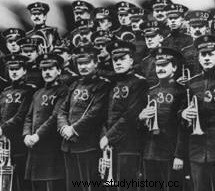 The Salvation Army is one of the oldest humanitarian organizations. Of English and Protestant origin, she combines spiritual mission and social mission. Its originality lies in its mode of organization, which is inspired by the military model. She intervenes wherever the need requires it and where her help is accepted. Its international headquarters are based in London, placed under the authority of a general who coordinates action at the global level and sets the main guidelines. Each territory has a national headquarters. In 2014, it is an international structure, in more than 120 countries, which brings together 2.5 million Salvationists around the world.
The Salvation Army is one of the oldest humanitarian organizations. Of English and Protestant origin, she combines spiritual mission and social mission. Its originality lies in its mode of organization, which is inspired by the military model. She intervenes wherever the need requires it and where her help is accepted. Its international headquarters are based in London, placed under the authority of a general who coordinates action at the global level and sets the main guidelines. Each territory has a national headquarters. In 2014, it is an international structure, in more than 120 countries, which brings together 2.5 million Salvationists around the world.
An army of peace
The Salvation Army was born in the midst of the industrial revolution, at the end of the 19th century. It was founded on July 5, 1865 by the British Methodist pastor William Booth (1829-1912), shocked by the sight of crowds of workers cramming into the poor neighborhoods of east London. It was called, at first, the East London Christian Mission, to become in 1878 The Salvation Army (Salvation Army).
 Its original motto “Soup. Soap. Salutation (Soup. Soap. Hi) reflects the deep thought of this pragmatic pastor. Born into a poor family, Booth worked from the age of 13, after basic studies. Self-taught, he reads a lot and trains himself in writing, he is then convinced that the change does not take place at the level of the masses, but in each individual. Social, political and economic progress must flow from a profound transformation of man by himself, "thanks to the power of the Gospel". Nevertheless, he knows that before talking about the Kingdom of Heaven, we must be able to offer him decent living conditions on Earth.
Its original motto “Soup. Soap. Salutation (Soup. Soap. Hi) reflects the deep thought of this pragmatic pastor. Born into a poor family, Booth worked from the age of 13, after basic studies. Self-taught, he reads a lot and trains himself in writing, he is then convinced that the change does not take place at the level of the masses, but in each individual. Social, political and economic progress must flow from a profound transformation of man by himself, "thanks to the power of the Gospel". Nevertheless, he knows that before talking about the Kingdom of Heaven, we must be able to offer him decent living conditions on Earth.
The activities of the mission grew rapidly, and in 1878 it was reorganized according to a paramilitary hierarchy which it has retained to the present day. Booth, its founder, was granted the rank of general, and its various members ranks corresponding to their functions. The organization was subsequently divided into territories corresponding to a country or a defined region.
The Salvation Army goes international
The internationalization of The Salvation Army began in 1880, when a group of members who left for the United States established the American branch in New York. The movement then spread throughout the world. The Salvation Army was particularly active during the two world wars with Allied soldiers. After the Second World War, she organized a large project called Marching Forward, to help the homeless by offering them food and a bed for the night, to promote evangelism, to prevent juvenile delinquency, assist veterans and their families, intervene in courts and in prisons, especially in countries ravaged by war.
 In 1993, the Salvation Army was present in ninety-nine countries and its officers preached the Gospel in one hundred and twenty-five languages and dialects. It had more than three million members worldwide, including twenty-five thousand officers trained in one of its thirty schools. It runs schools, maternity homes, children's homes and hotels where accommodation and meals are free. Salvation Army members preach, sing hymns and play music on city sidewalks; they hold hundreds of meetings in the streets every year. The doctrine of the group is based on the teachings of the Bible and remains fundamentally Christian. However, social services are offered without any discrimination based on race or religion.
In 1993, the Salvation Army was present in ninety-nine countries and its officers preached the Gospel in one hundred and twenty-five languages and dialects. It had more than three million members worldwide, including twenty-five thousand officers trained in one of its thirty schools. It runs schools, maternity homes, children's homes and hotels where accommodation and meals are free. Salvation Army members preach, sing hymns and play music on city sidewalks; they hold hundreds of meetings in the streets every year. The doctrine of the group is based on the teachings of the Bible and remains fundamentally Christian. However, social services are offered without any discrimination based on race or religion.
The activities of the Salvation Army are funded by voluntary contributions. Its official organ is The War Cry and its international headquarters are in London.
To go further
- The Salvation Army, by Raymond Delcourt. PUF, 1992.
- The Salvation Army in France.
